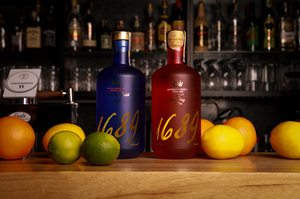To understand the Birth of Gin, we must take a look back at its evolutionary journey. Contrary to popular belief, gin did not originate from the British Isles, despite its popularity and association with the Brits. It was the Dutch with their Genever (or Jenever) who is known to be the birth-parent of gin, which is why Genever is often referred to as 'the father of gin'. Before Genever was brought to the British shores, Holland was already celebrated in Europe for their use of juniper berries in drinks - the first major mention of juniper-based health-related drinks appeared in a Dutch encyclopaedic work Der Naturen Bloeme ('the flower of nature') by Jacob van Maerlant from 1269, which includes a chapter on medicinal herbs including juniper featuring a reference to a juniper-based tonic, and it is publicly credited that Genever was the invention of Dutch chemist and alchemist, Franciscus Sylvius de Bouve (1614-1672), further cementing the drink’s Dutch roots.

Genever slowly trickled its way to British soil from the 1570s through sailors travelling back and forth between the countries, similar to modern-day travelling, bringing souvenirs home with you. However, it was during the Thirty Years War (1618-1648) that Genever became even more popular, as British troops travelled to central Europe to aid the Dutch in their fight against the Spanish army. Englishmen, now rubbing shoulders with the Dutch, began to get accustomed to the alcoholic substance, drinking it before battles in preparation (did someone say pre-drinks?) and leading to the coining of 'Dutch courage'.
Sure enough, Genever travelled back to England with the soldiers and began to rise in popularity. Domestic demand quickly increased, which was heightened by the interruption in the spirit trade due to the German and French involvement in the war, pushing for more imports from Holland. However, another Dutchman influenced making Genever, not only more popular but more fashionable...
In 1689 (does this date ring a bell to you?), the Dutch King William of Orange, who infamously sat on the English Throne with his wife Mary, boycotted imports of other alcoholic liquors, such as Brandy, due to the animosity at the time with France. Because of this, Genevers popularity heightened due to the accessibility or lack of other choices. Rumour had it, the demand got so much in England that Dutch distillers had to load the ships so quickly, they didn't have time to allow the Genever to rest for a couple of months as they traditionally did.
The following year, people began to notice an opportunity in the extremely popular alcohol market and thought it would be beneficial to reduce the economical reliance on foreign imports of the alcohol trade.
Further growth happened in England, with more artisanal and independent distilleries popping up all over the country which was partly due to the London Guild of Distillers ceasing, and the liberation of domestic distilling. However, due to low-quality raw material and a lack of technological advances, a new juniper-based spirit was born which was lower in purity than the original Dutch Genever. You may have heard of it... GIN.
Though the gin of that time still was not quite identical in terms of the gin we enjoy today, it was a more full-bodied and richer taste, generally known as 'Old Tom Gin'. The title was inspired by the wooden plaque commonly outside of bars where gin was mostly served, which formed a dark cat silhouette. Old Tom Gin was the next stepping stone in the journey of the gin we know and love today.
For most of the 18th Century, the production and selling of Gin had little, to no form of regulation. Combine that with the low-cost spirit versus ale and beer, and safer consumption compared with the contaminated water of cities, Gin became an integral part of a lot of poor families' diets. Due to its sweetness and alcohol content, gin was effective in suppressing appetite, and in most cases, cheaper than some foods. The production of Gin reached its peak in the middle of the 1740s, official tax registers indicate that 70 millions litres of Gin were produced over a population of 6 million in one year.
Who likes their gin in the bathtub? It was estimated that one in five people in London was illegally creating gin at home, commonly in their bathtubs, giving Gin in the bath a different meaning than what we are used to.
England at this point was under a 'gin craze'. English parliament had to intervene and enacted the so-called 'gin act' in 1751, raising taxes for both producers and retailers of the spirit. This had a heavy impact on the poorer communities, especially in London with a period of riots as a result. Many smaller distilleries had to shut and production was reduced to fewer people with more money who capitalised on the progressing spirit industry.
One man, in particular, moved to London from Scotland and opened up a distillery using the best grains and botanicals available, you may recognise his name... Alexander Gordon... but we won't talk much more about that.




